Hair has had a special significance in spiritual practice for millennia. Whether we consider it our crowning glory, a symbol of self, or the part of our bodies closest to the Divine, tending our hair as a spiritual practice has a long and varied history. We polytheists can use that foundation to support our own spiritual work.
How can hair be spiritual?
When considering our hair as a tool for our spiritual practice, it’s important to consider what our hair means to us, or what it might symbolize in our lives, before we start. Most of us take our hair for granted, but we often do have pretty intense feelings when we think about it a bit.
Is your hair merely something you ignore? A frame for your face? A method of self-expression? Perhaps it’s your favorite feature, or favorite fashion accessory, or preferred way to pamper yourself. Maybe your hair is a sexual thing for you, and you consider colors and styles to be your plumage. Maybe it’s something to hide behind, a curtain between you and the world. Maybe, like the Biblical Samson, you think of your hair as the seat of your power. Maybe your hair is one way you identify with your culture, heritage, or community. Maybe having someone else pet and play with your hair is relaxing. Maybe that makes you feel vulnerable, though, or you feel violated when other people touch your hair. Maybe it’s a safety hazard at work. Perhaps you don’t have any strong feelings attached to your hair but your spouse loves it.
Once we know how we relate to our hair, we can begin to see how we can relate it to our spiritual practice. If your hair is your favorite way to express yourself, then it can be used to express your devotion too. If it makes you feel vulnerable, maybe you want to cover it up so only those with whom you feel safest – including the Powers – can see it. If it’s a symbol of vanity for you, and you see vanity as a flaw you’re trying to improve, maybe shaving it off completely would be incredibly meaningful for you. If it’s a matter of heritage or cultural affiliation, then obviously look back to any hair practices that might be associated with that and work from there. If you don’t feel any kind of way about it, maybe you can start using it as a mindfulness tool and give it meaning.
There are no right answers here. It’s all about your personal relationship to both your hair and your practice, and that’s going to vary individually. Really give yourself some time to work it through, and keep it in mind as you check out the below options. You’ll naturally find that some of these methods speak to you more than others do. And that’s great! Those are the places to start exploring.
Some Practices to Consider
When it came time to put this post together I did a lot of research. Interestingly enough, everything I came up with fit rather neatly into three general categories. I love when that happens!
Those categories are Hair Care, Styling, and Covering.
Hair Care
This is the easiest and most subtle place to start. If we consider our hair to be a symbol of ourselves, and we either incorporate it into our spiritual practice or dedicate it to a specific Power, then the way we tend it can symbolize the way we tend our spiritual practice or the Power(s) to Whom our hair is dedicated. Cool, huh?
Some options here can include (but are not limited to):
- Ritually rinsing or washing our hair before ritual or during sacred baths
This is easy peasy. We can ritually rinse or wash our hair before engaging in ritual, on High Days, and/or on days sacred to a given Power. Light some candles, use smell-good products, sing or chant, lavish our hair with care and attention, the whole time keeping in mind the reason behind the action. Then, every time we see or smell our hair afterwards it’ll bring that symbolic action to mind again. It’s a great way to encourage mindfulness, and no one around will have the slightest idea that there’s anything different going on.
Using products made with ingredients or scented with a fragrance sacred to a Power
This takes the above idea and advances it a single step. For instance, let’s say you’re cultivating a relationship with Aphrodite (for Whom hair care would be an excellent devotional act). Why not use rose-scented hair products? The scent would be another reminder of Her, or even of Her place “above” you. That can work for a wide variety of different Powers! Can’t find anything scented for the Power you’re working with? Consider buying an unscented product and adding your own essential oils. Problem solved!Using only natural hair care products
This whole ideas runs right along the same path as “don’t use plastic ritual tools”. If you hold by that, and you’re tending your hair as a spiritual act, then it just makes sense to use natural products. This doesn’t have to be complicated, though. More and more natural hair products hit the market every day. My favorite brand – Shea Moisture – is even carried at Target. No trip to Whole Foods or Trader Joe’s required.

There are TONS of options when it comes to natural hair care!
- Using only hair care products we’ve ritually made ourselves
Again, this is a natural continuation of the above. Making our own products allows us to choose all the ingredients and scents with intent and then ritualize every step of the production process. Using what we’ve made would continuously remind us of the energy that went into the making. There are recipes and tutorials all over the internet, so I won’t get into all the possibilities, but here are a few to consider:- Making your own shampoo/conditioner soap bars
- Brewing tisanes (herbal teas) and using them as hair rinses
- Using soap nuts to wash and condition your hair
- Making various deep conditioning treatments
- Going no ‘poo (shampoo, that is)
- Never cutting our hair
This is a more long-term strategy, but it can be a pretty powerful one. If we see our hair as symbolic of our relationship to a Power, then cutting it could be seen as cutting the relationship. So don’t. Let your hair grow forever, only trimming it as necessary to maintain hair health. This naturally slides into some of the Styling options listed explored below, too.
- Shaving our heads
This is obviously a polar opposite view of the “never cutting our hair” option above. There the hair itself as seen as symbolic of the relationship to a Power, so cutting it would be bad. However, if we instead see hair as symbolic of our relationship to the world, to vanity or attachments or a secular life, then shaving it off can by symbolic of both our rejection of that and of our putting our spirituality first.
Shaving might strike some folks as more extreme than never cutting our hair, but it’s becoming more accepted for men and women every day. And don’t forget that different lengths and even styles are possible with shaving. It doesn’t have to mean “completely bald” unless that’s what you’d like it to mean.

Captain Picard, boldly (and baldly) going where no man has gone before.
Styling
Regardless of what methods you use to care for your hair, how you style it after can also become a significant part of your practice. As a bonus, many of these methods will work under full veils if you’d like to transition between the two.
Here are some options:
- Wear a Blessed/Sacred Accessory
This is a rather simple approach that won’t draw much attention.
Pick up a hair accessory – a jeweled bobby pin, for instance, or a hair comb – and dedicate that to whatever Power you’d like. Then wear it when you feel the need.There are so many options available that it’s easy to tailor our choices so that the color(s) and/or materials used in the jewelry are sacred to a particular Power. We can also do a formal dedication blessing, ask for the accessory to be blessed every morning during devotions before tucking it into our hair, etc.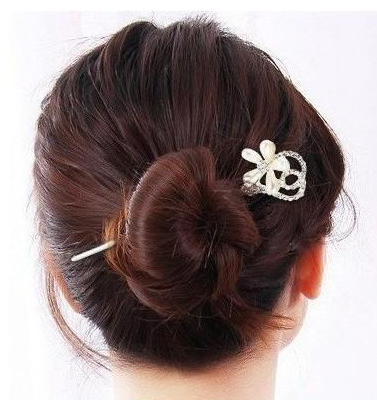
How about a hair stick?
Don’t worry if you’ve got little or no hair, either – you can still get in on this! If nothing else, headbands (and the things we attach to them) are options too. No hair required! Other options include hats of all kinds, beanies, etc. Get creative!
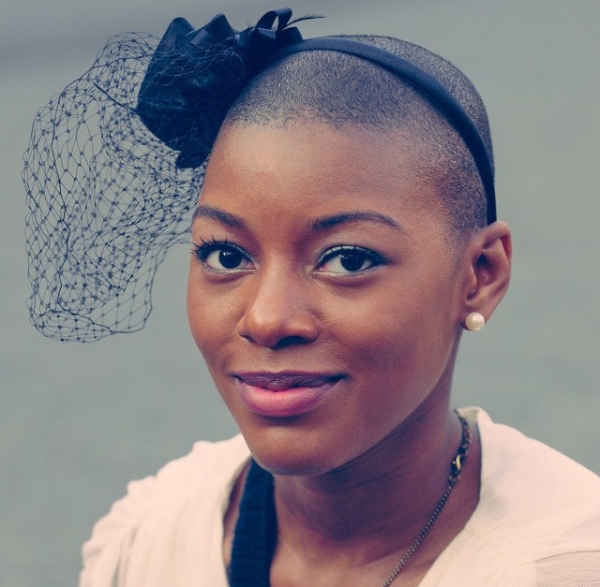
How gorgeous is this look?
- Dyes
The current trend of unnatural dye jobs plays beautifully into this. It’s hair styling via color correspondences! Do you follow a Power associated with purple and gold? Why not dye your hair purple and wear gold accessories? Scarlet, green, purple, brown, the sky’s the limit, and you’ll be reminded of the Power you’re honoring every time you look in the mirror. There are even temporary spray-in colors, or colored chalks, that let you do this for shorter periods of time. Those preferring natural hair care aren’t left behind either – natural box dyes, vegan semi-permanent colors, and henna are all options too.
This technique might work out very nicely for some folks depending on their God(s) and their lifestyles. Considering recent trends it’s also likely to be less fraught to explain to the general public, although you might run into problems in the workplace.
- Updos
Want to save the sight of your hair for the Powers or because modesty is a part of your practice, but don’t want to cover it entirely? Keep it up!
This very traditional approach can be as easy or complex as you like and definitely works for more professional environments. Crown braids. Buns. French twists. Snoods. Clips. Combs. Spin pins. Whatever works for your hair and lifestyle. (I don’t really recommend ponytails for this because they’re too free-flowing for me to consider them an updo, but you do you. 🙂 )
Personally I’m a huge fan of the Scunci Upzing. It’s made of two combs connected by elastic cording (my preference) or elasticized beadwork. The elastic makes the combs hold beautifully while adapting well to various lengths and hair thicknesses. I can securely put my hair up in about 5 seconds flat.
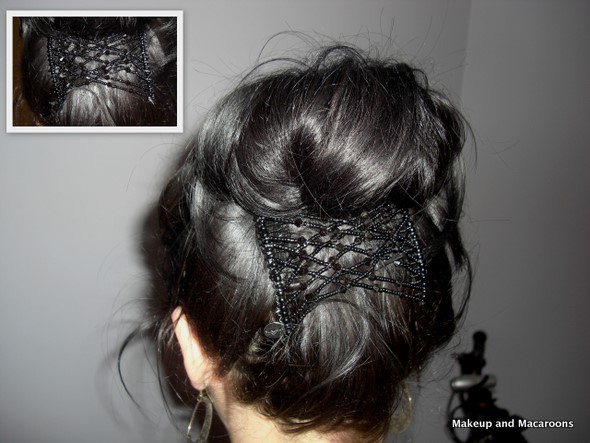
An Upzing used for a bun. Suitable for any professional environment, no? Works for a night out, too, and easily transitions between events.
Veiling (aka Covering)
Veiling can be loosely grouped into partial veiling and full veiling, but the lines between the two can be pretty blurry. For instance, lots of folks who do full covering may also leave their bangs exposed, or cover the crown but leave the back open. I define veiling as “anything put on the head to block visibility of the hair/scalp”, and that can include lots of options!
- Hats and Beanies
This is super easy, especially in the winter. Who doesn’t already wear beanies anyway? They don’t even rate a second look. They’re a little more noticeable in the summer, but there are enough styles that even that can be navigated.
On the plus side, hats and beanies have zero learning curve. Put your hair up (if you have any) and pull one of these beauties over it. Done! They’re also an excellent option for folks who want full coverage but don’t have the mobility to wrangle a scarf regularly.
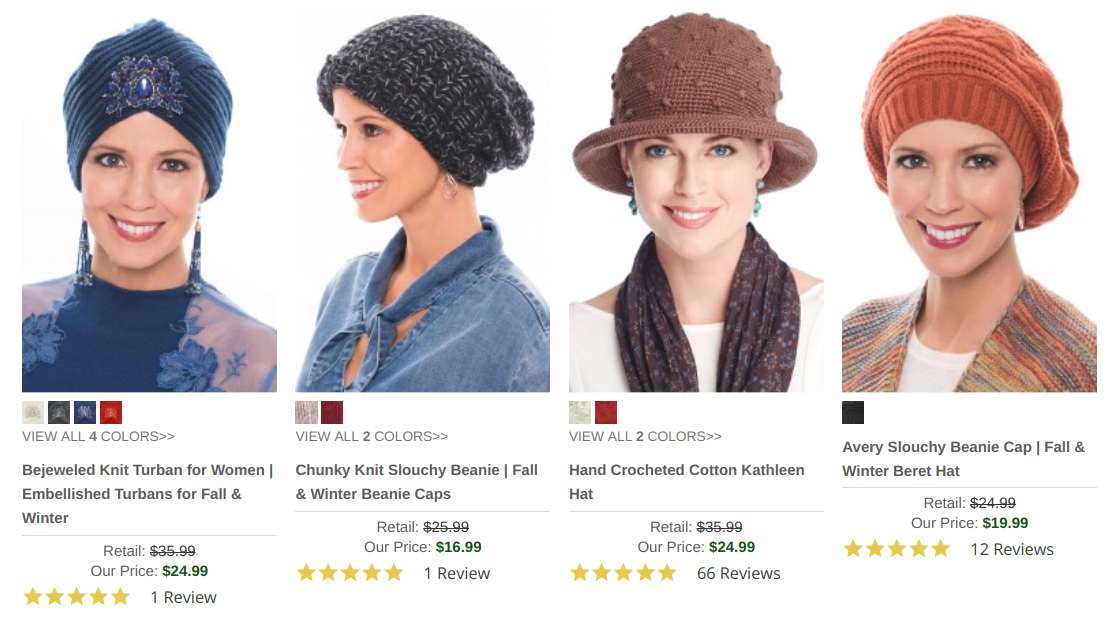
A selection of beanies and pull-on hats from https://www.headcovers.com.
Beanies provide adjustable coverage. You can wear them so your bangs show and your hair hangs out of the bottom, or you can wear them so your hair is completely covered. Not all hats are created equal in this regard, though. If you’re looking to completely cover all your hair, maybe check out places that cater to those experiencing medical hair loss (like the site in the photo above) as those products are designed to cover the whole scalp. Just keep in mind that they’re not designed for people with lots of hair.
If you do have a lot of hair, and find that even beanies don’t accommodate you, consider a “slap“, or a satin-lined cap. These are especially good for folks wanting to pamper their hair and/or looking for sleep cap options. They also come in a variety of contemporary colors and styles. The video below shows the versatility of the turban-style slap, but there are other styles that do the trick too.
- Wide Headbands and Bandanas
This is a great option for covering regardless of how much hair you have, and can get the idea of covering across without being particularly note-worthy. The ones marketed as yoga headbands seem to be particularly wide, or you could go even wider by looking for the stretchy tube underscarves used by hijabis.Even better, almost all of these styles (depending on print) are completely unisex. Guys can get in on this too! I’ve seen the above style of headband on guys with longer hair and dreads, for instance.
A yoga headband. It can be stretch to maximum coverage like this, but it can be folded or scrunched when less coverage is desired.
- Wear a Wig
This option is very well established in Jewish communities, where married Orthodox women are encouraged to cover for modesty reasons. Wigs worn for this purpose are called sheitels, and ideally they cover the hair so naturally that it’s hard to tell it’s covered at all. It’s a great option for those who want full coverage in the workplace without drawing attention, it can adapt to various trends as needed, and styling it can be fun. Wigs/sheitels are absolutely not cheap options, though, so be prepared for a significant up-front investment if you want to go this route, with even more required for upkeep.
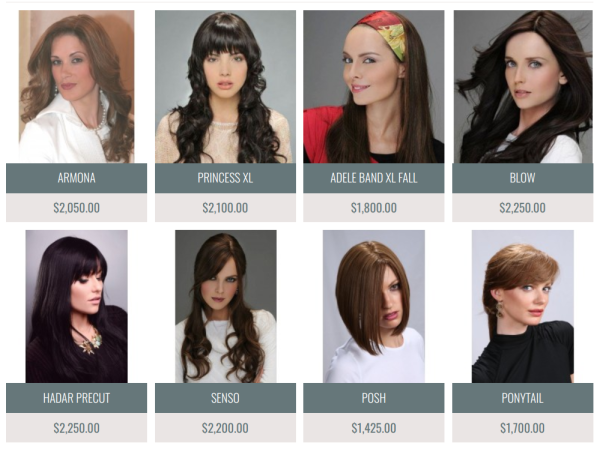
A sampling of sheitels and their prices from http://www.sheitel.com.
- Scarves
Scarves are the budget-friendly go-to for the majority of folks who cover, all around the world. They can easily be found for less than $20, in a wide variety of colors and materials, and the same scarf can be worn in a variety of creative ways. I recommend checking out Youtube for a plethora of different styles, as there’s no way I can cover even a tenth of the possibilities out there!
What I can do is help with sizes. While technically a scarf is simply a piece of fabric of just about any measurement, there are some standardized size ranges that dictate the kinds of wraps we can do with them. I’ve listed the most common ones below to help you narrow down styles you might be interested in. I’ll let Youtube do the rest. 🙂
- Bandanas: A bandana is really just a small square scarf (the size often used for neck scarves), but with a very distinctive “bandana” print on a whole rainbow of colors. They typically measure 22″ square, but a jumbo size of 27″ square is also available. Bandanas are great for headbands and partial covers, and make awesome skullcaps for folks with short hair and bald scalps.

- Wearing a bandana as a skullcap. A particularly masculine look.
- Square Scarves: Typically larger than a bandana, square scarves used for covering generally hover between 36″ square and 44″ square. They’re great for those preferring retro looks, turbans, and Turkish hijab styles, but they aren’t as flexible as rectangular scarves when it comes to tying options.

Yes, this Turkish hijab style is done with a regular square scarf. The stiff front is achieved by folding the scarf corner-to-corner and inserting a flexible piece of cardboard or plastic in the fold before tying.
- Rectangular Scarves: There are lots of sizes possible here, but the typical size used for covering tends to be around 28″ wide and 70″ long. Much larger than that and it’s unmanageable, while anything much smaller won’t provide enough coverage. Thinner rectangular scarves can make excellent sashes, though, that can be worn on top of another wrap or on their own for a pop of color/interest. These are the scarves most often used for both tichels and hijabs.
- Infinity Scarves: An infinity scarf is a simply a rectangular scarf that’s been sewn together along the short ends to make a long loop. They’re not as standardized size-wise as rectangular scarves but the above measurements for good coverage still apply, so check sizes before buying. Infinity scarves make super-simple hijabs, can be used as tichels with a little work, and are especially nice for draping and pinless styles.
- Bandanas: A bandana is really just a small square scarf (the size often used for neck scarves), but with a very distinctive “bandana” print on a whole rainbow of colors. They typically measure 22″ square, but a jumbo size of 27″ square is also available. Bandanas are great for headbands and partial covers, and make awesome skullcaps for folks with short hair and bald scalps.
A Final Note on Timing
Please note that timing for all of these can vary. We can do any of these as frequently or sporadically as we’d like, on whatever schedule suits us and our practice. I fully cover every time I leave the house but prefer to rely on updos at home. Some folks only cover when at shrines/altars, or while praying, and others only uncover at those times. Some save it for High Days, and others on days sacred to various deities, and still others only toss a scarf over their heads when they feel a call to do it. Feel free to experiment!
The goal of all of these practices is to bolster and support your spiritual practice. If anything on this list does that for you, then yay! You’ve got a new tool! If it doesn’t, though, or you find that these practices are actually distracting, then by all means don’t use them. Tools need to suit the user, and one of the joys of polytheism is that we’re encouraged to find our own way as we go. May you find whatever best works for you!
Thank you for this post! Four or five years ago I dyed my hair to try and be closer to my Goddess. At the time I didn’t realise how powerful a form of invocation it could be- for something I did on a sudden whim! I find it so amazing how hair has such complex and rich symbolism across cultures and religions